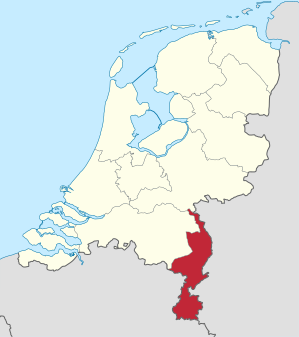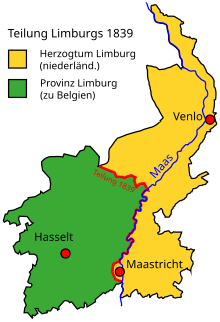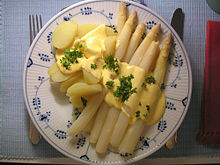Limburg Province (Netherlands)
|
Limburg Province of the Netherlands |
|
| coat of arms | flag |

|

|
| location | |
|---|---|
| Basic data | |
| Capital | Maastricht |
| Biggest town | Maastricht |
| ISO 3166-2 code | NL-LI |
| Website | www.limburg.nl |
| anthem | Waar in 't bronsgroen eikenhout |
| politics | |
| Royal Commissioner | Theo Bovens ( CDA ) |
| Ruling parties | CDA , FvD , PVV , VVD |
| population | |
| Residents | 1,115,875 ( 7th of 12 ) |
| Country share | 6.5% of the Dutch |
| Population density | 520 inhabitants per km² ( 4th of 12 ) |
| Religion (2015, CBS ) | 64% - Roman Catholic 4% - Islam 1% - Dutch Reformed 1% - Protestant 2% - other 28% - none |
| geography | |
| surface | 2,209.84 km² |
| - country | 2,146.80 km² (11th of 12) |
| - Water | 63.04 km² |
| height | 10 to 322.5 m above sea level NAP |
| Coordinates | 51 ° 13 ' N , 5 ° 56' E |
| Administrative division | |
| Communities | 31 |
|
Topography of Limburg |
|
Limburg (sometimes also Dutch or Nederlands Limburg to demarcate the Belgian province of the same name ) is the southernmost of the twelve provinces of the Netherlands ; their capital is Maastricht . The province of Limburg lies in the border area with Germany and Belgium in the Euregio Meuse-Rhine in the south and the Euregio Rhine-Meuse-North in the north. In the north-west it borders on the province of Noord-Brabant and in the far north on the province of Gelderland . On January 31, 2019, Limburg had 1,115,875 inhabitants.
geography
Limburg consists primarily of the Geest . In the south the province is hilly and has very fertile loess soils that are ideal for agriculture. The most important river is the Meuse , which flows along its entire length from south to north through the province. Hard coal was mined in South Limburg ; near Kerkrade and Heerlen , pointed cone heaps testify to the remains of former mining . Limburg is the only province in the Netherlands that is completely above sea level. The highest windmill in the Netherlands is located in the province, on the 216 meter high Vrouwenheide near the municipality of Voerendaal ; in Vijlen is the highest church tower in the Netherlands at a height of up to 242 m above NAP . The highest point in the European Netherlands is 322.7 m at the border triangle on the Vaalserberg (near Aachen ) in Limburg.
history
Before the occupation by the troops of the French Revolution in 1795, what would later become the province of Limburg consisted of a patchwork of areas, only a tiny part of which belonged to the old Duchy of Limburg . The cities of Maastricht , Venlo and the State of Übermaas on the right bank of the Meuse belonged to the State Republic of the United Netherlands . The remaining part of the area east of the Meuse came to the Netherlands in 1815 through the Congress of Vienna . He had previously the Spanish and later the Austrian Habsburgs and z. T. belongs to imperial German rulers. The congress did not restore the chaotic borderline state before the French Revolutionary Wars, but instead exchanged claims to former enclaves. So Prussia received the areas of Schenkenschanz and Herzogenrath , the Netherlands received the areas of Born and Sittard .
Congress of Vienna 1815
The province of Limburg emerged in 1815 from the department of Niedermaas (French: Meuse-Inférieure ) . After thinking about names like “Provincie Maastricht”, “Maasdal” and “Opper Gelder”, the Dutch King Willem I decided on this name. Now that the northern and southern Netherlands were reunited, this naming should help to preserve the memory of the medieval Duchy of Limburg . Only a tiny part of the new province, however, has ever belonged to this duchy. So the name is indirectly reminiscent of the castle in what is now Limbourg in the province of Liège . So it was not a matter of restoring this old Duchy of Limburg, as is often claimed. The western part of the so-called upper quarter of the former Duchy of Geldern with the cities of Venlo and Roermond formed the northern part, more than half of the later Dutch province.
Division of 1839
After the revolution in Belgium in 1830, the entire province with the exception of Maastricht and the far north was initially in Belgian hands with Valkenburg as the provisional capital. Even after the ten-day campaign, the majority remained under Belgian control. Venlo was evacuated again in the course of an armistice in 1833. As part of a final solution, today's state border was established by the London Protocol of 1839; Limburg was divided into a Dutch and a Belgian province .
Because the French-speaking western part of Luxembourg had fallen to Belgium as the province of Luxembourg , the Dutch government only represented half as many residents in the Bundestag of the German Confederation . In order not to lose voting weight, the king also made the province of Limburg a Duchy of Limburg . This duchy was included as a member state in the German Confederation ("Deutsch-Limburg"), so that the king retained his old voting weight for Limburg-Luxemburg. Since the German Confederation was just a federation of states, this solution seemed tolerable.
During the National Assembly in the Paulskirche in Frankfurt , Limburg was represented by two members after the revolution of 1848. Both were advocates of an independent Limburg within the emerging German Empire . They had a tailwind from the population because of the king's conservative policies and high taxation. However, after concessions in the summer of 1848, the idea lost its popularity in Limburg; a Limburg member state in a German federal state would also have led to foreign policy conflicts.
In 1866 the German Confederation was dissolved and the Province of Limburg no longer belonged to a German association. For tactical reasons Otto von Bismarck demanded in 1867 (in vain) that Limburg should become part of the new federal state, the North German Confederation . Limburg was just one Dutch province among others, but it still differed from one another until the First World War through a strong sense of self.
After the First World War
At the end of the First World War, Belgium intended to annex the Dutch province of Limburg and Zeeuws Vlaanderen . This was justified by the fact that Dutch neutrality would have favored Germany during the war. Then there were large demonstrations in Dutch Limburg, including in Maastricht on December 6, 1918, in Zeeuws Vlaanderen and in many other places in the Netherlands, in favor of these two parts of the country remaining with the Netherlands. In Limburg, the Netherlands, the Provinciale Comite Limburg aan Nederland (Provincial Committee “Limburg to the Netherlands”) organized the population's resistance to annexation. This resistance was successful. At the Paris Peace Conference in January 1919, Belgium was unable to enforce its demands against the Netherlands.
politics
The provincial parliament ( Dutch Provinciale Staten ) has its seat in the Provinciehuis in the provincial capital Maastricht . According to the population in the province, the parliament has 47 seats. Colloquially, the king's commissioner in Limburg is called the governor and the Provinciehuis Gouvernement .
The last provincial election took place on March 20, 2019.
At the head of the provincial administration are the Gedeputeerde Staten , presided over by the King's Commissioner . Since October 2011 this has been the Christian Democrat Theo Bovens . The remaining members of the Gedeputeerde states are elected by the Provincial States . Since 2019 owned by the provincial-executive representatives of the parties CDA , FvD , PVV and VVD to, also a politician of against the will of their party GroenLinks and a member of the provincial party a Lokaal-Limburg , which was not nominated by his party concluded local group of voters.
Communities
As of 2019 there are 31 municipalities in the province:
- Beek (15,935)
- Beekdaelen (35,771)
- Beesel (13,515)
- Bergen (13,125)
- Brunssum (28,064)
- Echt-Susteren (31,645)
- Eijsden-Margraten (25,648)
- Gennep (17,063)
- Gulpen-Wittem (14,262)
- Heerlen (86,825)
- Horst aan de Maas (42,336)
- Kerkrade (45,699)
- Landgraaf (37,567)
- Leudal (35,656)
- Maasgouw (23,714)
- Maastricht (121,362)
- Meerssen (18,901)
- Mook en Middelaar (7815)
- Nederweert (17,009)
- Peel en Maas (43,342)
- Roerdalen (20,619)
- Roermond (58,202)
- Simpelveld (10,501)
- Sittard-Geleen (92,606)
- Stone (24,960)
- Vaals (10,109)
- Valkenburg aan de Geul (16,496)
- Venlo (101,484)
- Venray (43,332)
- Voerendaal (12,442)
- Weert (49,870)
(Residents on January 31, 2019)
Places with city rights
In the province of Limburg there are 13 towns with municipal rights :
Regio Parkstad Limburg
Parkstad Limburg is an association of the former mining area with the municipalities:
particularities
The province of Limburg is very different from the rest of the Netherlands. For example, all of Limburg is strongly Roman Catholic. In addition to the official Dutch language, the Limburg population has its own language, Limburg , which is mainly influenced by German as well as French or Celtic and is cultivated in particular in the local communities. Limburg culture is also strongly influenced by German and French, especially in South Limburg . In contrast to most of the rest of the Netherlands, the local dialect is widely used in all age groups.
Economy and tourism
In 2011, the regional gross domestic product per inhabitant, expressed in purchasing power standards , was 115.85% of the EU-28 average . In 2017 the unemployment rate was 4.7%.
The service and tourism sector plays a major role in the Limburg economy. The chemical company DSM with its headquarters in Heerlen is of economic importance, and the “ Maastricht Aachen Airport ” near Beek is also noteworthy. The southern part of Limburg in particular has been one of the two main fruit-growing regions in the Netherlands for a long time. For about four decades, large parts of the tree population have disappeared to mine gravel. After the mining had ended, large areas of water remained, known as the so-called Grindgaten or Maasplassen . They are now used for local recreation and water sports. In the southeast of Limburg (as in the neighboring Aachen area) coal mining, especially hard coal mining, was operated, which was discontinued in 1974. Today the area is one of the economically weakest in the Netherlands.
There are four regional tourism associations in the province of Limburg: VVV Maastricht, VVV Zuid-Limburg, VVV Midden-Limburg and SPNL ( Stichting Promotie Noord Limburg ). The association SVL ( Samenwerkende VVV's Limburg ) is responsible for the overall coordination and for strengthening a common tourism strategy. For example, they market the entire province of Limburg on a national and international level, including the campaign "Limburg - Liefde voor het leven" ("Limburg - A lifelong love ”) (propagated in Germany under the motto“ Limburg - Enjoy your life ”).
The south of Limburg , to a certain extent at the interface between the last foothills of the Ardennes / High Fens and the Eifel, is also called the “ Dutch Mountains ” in English due to its distinctly hilly topography . The area is the venue for the Amstel Gold Race every year, has hosted the road cycling world championship four times and numerous stages of major road races and the Tour de France (such as on July 4, 2006). In addition to the many day trippers who explore South Limburg by bike , the annual Limburgs Mooiste cycling event regularly attracts up to 10,000 amateur cyclists from all over Europe.
Culinary
The best known is the Limburg asparagus, next to it “limburgse vlaai” , fruit cake with pudding filling. Limburg beer is influenced by the Belgian beer culture .
Personalities
- Pierre Cuypers (1827–1921), Dutch architect and arts and crafts entrepreneur
- Eugène Dubois (1858–1940), Dutch anthropologist and geologist
- Frans Schraven (1873–1937), Dutch bishop in China
- Peter Debye (1884–1966), physicist, theoretical chemist and Nobel Prize winner in chemistry
- Pierre Lardinois (1924–1987), Dutch politician of the KVP, later CDA
- René van der Linden (* 1943), CDA politician
- André Rieu (* 1949), Dutch violinist, orchestra conductor and music producer
- Huub Stevens (* 1953), former Dutch soccer player, soccer coach
- Peter Winnen (* 1957), former Dutch professional cyclist, journalist and book author
- Jos Luhukay (* 1963), former Dutch soccer player, soccer coach
- Geert Wilders (* 1963), Dutch PVV politician and filmmaker
- Erik Meijer (* 1969), former Dutch football player
- Jos Verstappen (* 1972), former Formula 1 racing driver
- Sjeng Schalken (* 1976), former Dutch tennis player
- Rens Blom (* 1977), former Dutch athlete, world champion in pole vault
- Mark van Bommel (* 1977), Dutch football player
- Paul Verhaegh (* 1983), Dutch football player
See also
literature
- Pierre JH Ubachs: Handbook voor de geschiedenis van Limburg . Lost, Hilversum 2000, ISBN 90-6550-097-9 .
Web links
- Official website of the Dutch province of Limburg
- Website of the Limburg party concern ( Memento from February 11, 2007 in the Internet Archive )
- Tourism in the Dutch province of Limburg
- Wikipedia in Limburgish
- Map of the Dutch province of Limburg from 1868
Individual evidence
- ↑ Religieuze betrokkenheid; kerkelijke gezindte; regio. CBS , December 22, 2016, accessed November 19, 2018 (Dutch).
- ↑ Bevolkingsontwikkeling; regio per maand . In: StatLine . Centraal Bureau voor de Statistiek (Dutch)
- ↑ Jos Venner: Geschiedenis van Limburg , Deel II, Limburgs Geschied- en Oudheidkundig Genootschap, Maastricht 2001, ISBN 90-71581-11-X , here: page 21.
- ^ Ad Welschen: Introduction to the Contemporary Dutch Society and Culture , International School for Humanities and Social Sciences, University of Amsterdam, 2000–2005.
- ^ Karl August Steifensand: The Duchy of Limburg as a German Federal State , p. 21, Verlag E. Gehrich & Cie., Crefeld 1848; Googlebooks, accessed May 21, 2019.
- ^ Jan JB Kuipers, Robbert Jan Swiers: Het verhaal van Zeeland . Lost, Hilversum 2005, p. 169.
- ↑ Pierre JH Ubachs: Handboek voor de geschiedenis van Limburg . Lost, Hilversum 2000, p. 353.
- ↑ a b Gerardus JB Verbeet: 1914–1918, moeilijke jaren voor de both Limburgen. Solidarity en samenwerking. Maastricht, Belgian frontstad op neutraal gebied . Mosae Libro, Maastricht 2014, ISBN 978-90-8666-323-1 , pp. 106–127.
- ↑ Wilhelmina : Lonely and yet not alone . Evangelisches Verlagswerk, Stuttgart 1961, p. 170.
- ^ Kasper Wagemans: Limburg en het Belgische annexionisme, 1918–1920 . In: Studies over de sociaal-economische geschiedenis van Limburg , Vol. 53 (1999), pp. 89-134.
- ↑ Verkiezingsuitslagen Provinciale Staten 1918 - heden Kiesraad
- ^ NOS: Geen coalitie, wel bestuurders van FvD and PVV in Limburg
- ↑ Bevolkingsontwikkeling; regio per maand . In: StatLine . Centraal Bureau voor de Statistiek (Dutch)
- ↑ Gemeenten. In: parkstad-limburg.nl. Stadsregio Parkstad Limburg, accessed on January 4, 2019 (Dutch).
- ↑ Eurostat yearbook of the regions 2014 : ( Chapter 5: Economy ; PDF, 18 pages, approx. 2.0 MB) and ( Eurostat source data for Chapter 5: Economy ; XLS format, approx. 536 kB), ISBN 978-92 -79-11695-7 , ISSN 1830-9690 (English)
- ↑ Unemployment rate, by NUTS 2 regions. Retrieved November 5, 2018 .










